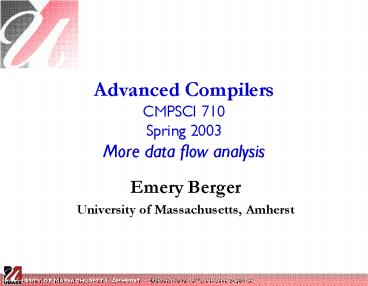Advanced Compilers CMPSCI 710 Spring 2003 More data flow analysis
Title:
Advanced Compilers CMPSCI 710 Spring 2003 More data flow analysis
Description:
UNIVERSITY OF MASSACHUSETTS, AMHERST DEPARTMENT OF COMPUTER SCIENCE ... d(G) = 1 for reducible flow graphs. UNIVERSITY OF MASSACHUSETTS, AMHERST DEPARTMENT OF ... –
Number of Views:35
Avg rating:3.0/5.0
Title: Advanced Compilers CMPSCI 710 Spring 2003 More data flow analysis
1
Advanced CompilersCMPSCI 710Spring 2003More
data flow analysis
- Emery Berger
- University of Massachusetts, Amherst
2
More Data Flow Analysis
- Last time
- Program points
- Lattices
- Max fixed point
- Reaching definitions
- Today
- Iterative Worklist Algorithm
- actual algorithm, examples
3
From Last TimeInformal Description
- Define lattice to represent facts
- Attach meaning to lattice values
- Associate transfer function to each node
- Initialize values at each program point
- Iterate through program until fixed point
4
Iterative Worklist Algorithm
for v 2 V IN(v) ? OUT(v) Gen(v) worklist
à V while (worklist ? ?) v à remove(worklist)
oldout(v) OUT(v) IN(v) p 2 PRED(v) OUT(p)
OUT(v) GEN(v) (IN(v) KILL(v)) if
(oldout(v) ? OUT(v)) worklist à worklist
SUCC(v)
5
Iterative Worklist AlgorithmAnalysis
- Worst-case runtime
- Visit each basic block
- up to N
- compute successors
- perform set operations (bit vectors)
- Can we bound number of passes?
6
Bounding Expected Runtime
- Order mattersvisit nodes in reverse postorder
- Nodes visited roughly after its predecessors
- Intuition accumulate as much info as possible
before processing each node
7
Reverse Postorder
visit(n) visited(n) Ã true for s 2 SUCC(n)
if not visited(s) visit(s) postorder(n)
à count count à count 1 count à 1 for each
node n visited(n) Ã false visit (entry) for
each node n rPostorder(n) Ã NumNodes
postorder(n)
8
Reverse PostorderExamples
1
visited(1) visited(2) visited(3)
visited(4)
postorder(1) postorder(2) postorder(3)
postorder(4)
2
3
4
9
Reverse PostorderExamples
1
visited(1) visited(2) visited(3)
visited(4) visited(5) visited(6)
visited(7)
postorder(1) postorder(2) postorder(3)
postorder(4) postorder(5) postorder(6)
postorder(7)
2
3
4
5
7
6
10
Loop Interconnectiveness
- Defined as d(G) maximum number of back edges on
any acyclic path in graph G - up to N
- but usually 3 and often 1
- d(G) 1 for reducible flow graphs
11
Loop InterconnectivenessExamples
1
1
1
2
2
2
3
3
4
3
4
4
d(G)
d(G)
d(G)
12
Iterative Worklist Algorithm,Modified
for v 2 V IN(v) ? OUT(v) Gen(v) worklist
à rPostorder(V), changed à true while (changed)
changed à false for v 2 worklist oldout(v)
OUT(v) IN(v) up 2 PRED(v) OUT(p)
OUT(v) GEN(v) u (IN(v) KILL(v)) if
(oldout(v) ? OUT(v)) changed à true
13
Reaching Definitions Example
Entry
postorder(1) postorder(2) postorder(3)
postorder(4) postorder(5) postorder(6)
postorder(7)
visited(1) visited(2) visited(3)
visited(4) visited(5) visited(6)
visited(7)
1 parameter a
2 parameter b
3 xab
4 yab
5 if y gt ab
6 a a1
Exit
7 x ab
14
For Reaching Definitions
- For reaching defs, u
- Gen(d v exp) d
- on exit from block d, generate new definition
- Kill(d v exp) defs(v)
- on exit from block d, definitions of v are
killed - Computing In(S) and Out(S)
- In(S) P in PRED(S)Out(P)
- Out(S) Gen(v) (In(v) Kill(v))
- Out(Entry)
15
Reaching Definitions Example
Entry
defs(x) 3, 7 defs(y) 4 defs(a) 1,
6 defs(b) 2
1 parameter a
2 parameter b
reverse postorder 1, 2, 3, 4, 5, 6,
7 changed
3 xab
4 yab
5 if y gt ab
6 a a1
Exit
7 x ab
16
Iterative Worklist AlgorithmRevised Analysis
- Stabilizes in at most d(G) 2 iterations
- d(G) 1 iterations to propagate data
- 1 iteration to detect stability
- as noted, d(G) usually 3, often 1
- Each pass computes
- O(E) meets (sets of size defs)
- O(N) other operations
- Effectively O(N) complexity
- Note for backwards analysis, use postorder
17
Other Data Flow Problems
- Definitely uninitialized variables
- Gen(S)
- Kill(S)
- Out(Entry)
- u
- Possibly uninitialized variables
- Gen(S)
- Kill(S)
- Out(Entry)
- u
a 3 b 5 if (a 2) c 1 else b 2
18
Next Time Even More Data Flow!
- Live variable analysis
- backwards problem
- Constant propagation
- Supplementary paper available
- Wegman Zadeck, TOPLAS 1991































